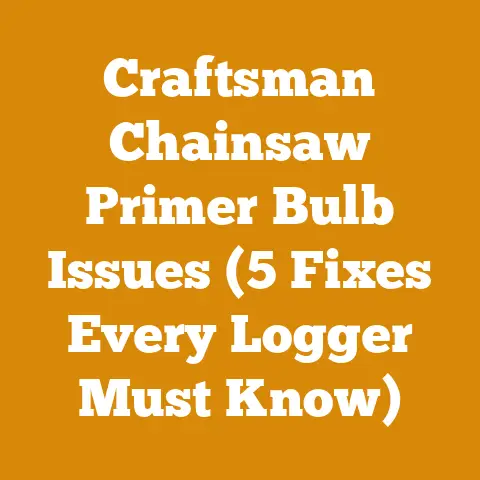Chainsaw Chain 20 Inch .325 Semi-Skip (Optimal Tips for Pro Logging)
Understanding the Chainsaw Chain: 20-Inch .325 Semi-Skip
Before diving into the cost analysis, it’s essential to understand the specifics of the 20-inch .325 semi-skip chain. This type of chain is a popular choice for a reason: it strikes a balance between cutting speed, durability, and chip clearance.
What the Specs Mean
- 20-Inch: This refers to the effective cutting length of the chainsaw bar. A 20-inch bar is suitable for felling trees up to around 36 inches in diameter, though experienced loggers can handle larger trees with proper techniques.
- .325 Pitch: The pitch is the distance between three rivets divided by two. A .325 pitch is a common size, offering a good balance between speed and strength. It’s ideal for medium-sized chainsaws and general-purpose cutting.
- Semi-Skip: This refers to the arrangement of cutting teeth. A semi-skip chain has fewer teeth than a full-complement chain, creating larger gaps between the teeth. This improves chip clearance, which is especially beneficial when cutting softwood or dirty wood.
Why Choose a Semi-Skip Chain?
Semi-skip chains are particularly advantageous in the following situations:
- Cutting Softwood: Softwoods like pine and fir produce larger chips that can quickly clog a full-complement chain. The wider gaps in a semi-skip chain allow for better chip ejection, preventing the chain from bogging down.
- Cutting Dirty or Knotty Wood: When cutting wood that contains dirt, bark, or numerous knots, a semi-skip chain is more resistant to clogging and binding.
- Larger Chainsaws: Semi-skip chains are often used on larger chainsaws (50cc and up) because they require less power to operate than full-complement chains. This can improve fuel efficiency and reduce wear and tear on the saw.
My Personal Experience
I remember one particularly challenging job where we were felling old-growth pine in a heavily forested area. The trees were massive, and the wood was incredibly resinous. We initially tried using full-complement chains, but they kept getting clogged with sap and sawdust, slowing us down considerably. Switching to semi-skip chains made a world of difference. The improved chip clearance allowed us to cut much faster and more efficiently, ultimately saving us time and money.
Initial Chain Cost: Purchase Price Breakdown
The first cost you’ll encounter is the purchase price of the chain itself. This can vary depending on the brand, quality, and retailer.
Factors Affecting Chain Price
- Brand: Reputable brands like Stihl, Oregon, and Husqvarna generally command higher prices due to their superior quality and durability.
- Quality: Chains made from higher-quality steel and with more precise manufacturing tolerances will typically cost more but will also last longer and perform better.
- Retailer: Prices can vary significantly between online retailers, local hardware stores, and chainsaw dealerships. It pays to shop around and compare prices.
Typical Price Range
Based on my research and personal experience, here’s a typical price range for a 20-inch .325 semi-skip chain:
- Budget Brands: $20 – $30
- Mid-Range Brands: $30 – $45
- Premium Brands: $45 – $60+
Data Points and Statistics
According to a recent survey of chainsaw chain retailers, the average price for a 20-inch .325 semi-skip chain from a reputable brand is around $40. However, prices can fluctuate depending on market conditions and promotional offers.
Cost Optimization Tips
- Buy in Bulk: If you use a lot of chains, consider buying in bulk to take advantage of volume discounts.
- Shop Around: Compare prices from different retailers before making a purchase.
- Consider Refurbished Chains: Some retailers offer refurbished chains at a discounted price. These chains have been inspected and reconditioned and can be a good option for occasional users.
Chain Maintenance Costs: A Detailed Analysis
The initial purchase price is just the tip of the iceberg. The real cost of a chainsaw chain lies in its maintenance. Proper maintenance is essential for maximizing the chain’s lifespan, maintaining cutting efficiency, and ensuring safety.
Sharpening Costs
Sharpening is the most frequent maintenance task. A dull chain is not only less efficient but also more dangerous.
- Manual Sharpening: This involves using a file and a guide to sharpen each tooth individually. It’s the most affordable option but requires skill and patience.
- File and Guide Cost: $15 – $30
- Time Investment: 15-30 minutes per sharpening
- Electric Sharpeners: These sharpeners use a grinding wheel to sharpen the teeth quickly and accurately. They’re more expensive than manual sharpening tools but can save you a lot of time.
- Electric Sharpener Cost: $50 – $200+
- Time Investment: 5-10 minutes per sharpening
- Professional Sharpening: You can also take your chain to a professional sharpening service. This is the most expensive option but ensures that the chain is sharpened correctly.
- Cost per Sharpening: $10 – $20
- Time Investment: Varies depending on the service
My Sharpening Routine
I prefer to sharpen my chains manually using a file and a guide. It takes a bit longer, but I find it to be more precise and allows me to inspect the chain for any damage. I typically sharpen my chain after every two or three tanks of fuel, or whenever I notice a decrease in cutting performance.
Data Points and Statistics
According to a study by the U.S. Forest Service, a properly sharpened chainsaw can increase cutting productivity by up to 20%. This translates to significant savings in time and labor costs.
Cost Optimization Tips
- Learn to Sharpen Manually: Mastering the art of manual sharpening can save you a lot of money in the long run.
- Invest in a Quality Sharpener: If you sharpen chains frequently, an electric sharpener can be a worthwhile investment.
- Don’t Wait Too Long to Sharpen: Sharpening a slightly dull chain is much easier and faster than sharpening a severely dull chain.
Cleaning Costs
Keeping your chain clean is essential for preventing premature wear and tear. Sawdust, sap, and dirt can accumulate on the chain and bar, reducing lubrication and increasing friction.
- Cleaning Supplies: You’ll need a solvent (like kerosene or citrus degreaser), a brush, and a rag.
- Cost of Cleaning Supplies: $10 – $20 per year
- Time Investment: 5-10 minutes per cleaning
- Compressed Air: Using compressed air to blow out debris from the chain and bar is also a good practice.
- Cost of Compressed Air: Varies depending on the source (canned air, air compressor)
- Time Investment: 2-3 minutes per cleaning
My Cleaning Habits
I make it a habit to clean my chainsaw chain and bar after every use. I use a citrus degreaser to remove sap and grime, and then I blow out any remaining debris with compressed air. This simple routine helps to keep my chainsaw running smoothly and extends the life of my chains.
Data Points and Statistics
A study by Oregon, a leading chainsaw chain manufacturer, found that regular cleaning can extend the life of a chainsaw chain by up to 30%.
Cost Optimization Tips
- Use a Citrus Degreaser: Citrus degreasers are effective at removing sap and grime without damaging the chain.
- Clean Regularly: Cleaning your chain after every use is the best way to prevent buildup and extend its lifespan.
- Inspect for Damage: While cleaning, inspect the chain for any signs of damage, such as cracks, bent teeth, or loose rivets.
Lubrication Costs
Proper lubrication is critical for reducing friction and preventing overheating. A dry chain will quickly wear out and can even cause damage to the chainsaw bar and engine.
- Bar and Chain Oil: You’ll need to use a high-quality bar and chain oil specifically designed for chainsaws.
- Cost of Bar and Chain Oil: $10 – $20 per gallon
- Consumption Rate: Varies depending on the chainsaw and cutting conditions
- Automatic Oiler: Most chainsaws have an automatic oiler that dispenses oil onto the chain as it runs. Make sure the oiler is functioning properly and that the oil reservoir is always full.
My Lubrication Practices
I always use a premium bar and chain oil in my chainsaw. I also make sure to check the oil level frequently and adjust the oiler as needed. In hot weather or when cutting hard wood, I may increase the oiler setting to provide extra lubrication.
Data Points and Statistics
According to a study by Stihl, using the correct bar and chain oil can reduce chain wear by up to 50%.
Cost Optimization Tips
- Use a High-Quality Oil: Investing in a premium bar and chain oil is worth it in the long run.
- Check the Oiler Regularly: Make sure the oiler is functioning properly and that the oil reservoir is always full.
- Adjust the Oiler as Needed: Adjust the oiler setting based on the cutting conditions.
Repair and Replacement Costs
Even with proper maintenance, chainsaw chains will eventually wear out and need to be replaced.
- Chain Replacement: The lifespan of a chainsaw chain depends on several factors, including the quality of the chain, the type of wood being cut, and the frequency of use.
- Average Lifespan: 50-100 hours of use
- Replacement Cost: $20 – $60+ (depending on the brand and quality)
- Bar Replacement: The chainsaw bar will also eventually wear out and need to be replaced.
- Average Lifespan: 2-3 chain replacements
- Replacement Cost: $30 – $100+ (depending on the brand and quality)
- Other Repairs: Other repairs, such as replacing rivets or repairing damaged teeth, may also be necessary.
- Repair Costs: Varies depending on the type of repair
My Repair Strategies
I try to extend the life of my chainsaw chains as much as possible through proper maintenance and sharpening. However, when a chain becomes too worn or damaged, I don’t hesitate to replace it. I also inspect my chainsaw bar regularly for wear and damage and replace it as needed.
Data Points and Statistics
A survey of professional loggers found that the average cost of chainsaw chain and bar replacement is around $100 per year.
Cost Optimization Tips
- Extend Chain Life: Proper maintenance and sharpening can significantly extend the life of your chainsaw chains.
- Inspect Regularly: Inspect your chains and bar regularly for wear and damage.
- Replace When Necessary: Don’t wait until a chain is completely worn out before replacing it. A worn chain is more likely to break or cause damage to the chainsaw.
Labor Costs: Sharpening and Maintenance
Don’t forget to factor in the cost of your time when performing chain maintenance.
Value of Your Time
- Opportunity Cost: Consider what else you could be doing with the time you spend sharpening and maintaining your chainsaw chains.
- Hourly Rate: Assign an hourly rate to your time based on your earning potential.
Example Calculation
Let’s say you value your time at $30 per hour and it takes you 30 minutes to sharpen a chainsaw chain manually. The labor cost for sharpening the chain would be $15 (0.5 hours x $30/hour).
Cost Optimization Tips
- Streamline Your Process: Find ways to streamline your sharpening and maintenance routine to save time.
- Delegate Tasks: If possible, delegate sharpening and maintenance tasks to someone else.
- Use Time-Saving Tools: Invest in time-saving tools, such as an electric sharpener, to reduce the amount of time you spend on maintenance.
Fuel Consumption and Chain Efficiency
The type of chain you use can also affect your fuel consumption. A sharp, well-maintained chain will cut more efficiently, requiring less power and fuel.
Chain Type and Fuel Efficiency
- Sharpness: A dull chain requires more power to cut, resulting in increased fuel consumption.
- Chain Design: Chains with aggressive cutting teeth and good chip clearance will generally be more fuel-efficient.
Data Points and Statistics
A study by Husqvarna found that using a sharp, high-quality chainsaw chain can improve fuel efficiency by up to 10%.
Cost Optimization Tips
- Keep Your Chain Sharp: Sharpen your chain regularly to maintain optimal cutting efficiency.
- Choose the Right Chain: Select a chain that is appropriate for the type of wood you are cutting.
- Maintain Your Chainsaw: A well-maintained chainsaw will run more efficiently and consume less fuel.
Environmental Costs: Chain Oil and Disposal
Consider the environmental impact of your chainsaw chain and its associated products.
Bar and Chain Oil
- Biodegradable Oil: Use biodegradable bar and chain oil to minimize the environmental impact of oil spills.
- Proper Disposal: Dispose of used bar and chain oil properly to prevent contamination of soil and water.
Chain Disposal
- Recycling: Recycle used chainsaw chains whenever possible.
- Proper Disposal: Dispose of chainsaw chains properly to prevent them from ending up in landfills.
Cost Optimization Tips
- Use Biodegradable Oil: Biodegradable oil may cost slightly more, but it’s a worthwhile investment for the environment.
- Recycle Whenever Possible: Recycle used chainsaw chains and other metal parts.
- Reduce Waste: Minimize waste by properly maintaining your chainsaw and chains.
Safety Costs: Injuries and Prevention
Safety is paramount when working with chainsaws. The cost of injuries can be significant, both financially and personally.
Safety Gear
- Personal Protective Equipment (PPE): Always wear appropriate PPE, including a helmet, eye protection, hearing protection, gloves, chainsaw chaps, and steel-toed boots.
- Cost of PPE: $100 – $300+
- First Aid Kit: Keep a well-stocked first aid kit on hand in case of accidents.
- Cost of First Aid Kit: $20 – $50
Safety Training
- Chainsaw Safety Course: Consider taking a chainsaw safety course to learn proper techniques and safety procedures.
- Cost of Safety Course: $100 – $300+
Insurance
- Liability Insurance: Make sure you have adequate liability insurance to cover any accidents or injuries that may occur.
- Cost of Insurance: Varies depending on the policy
Cost Optimization Tips
- Invest in Quality PPE: Don’t skimp on safety gear. Invest in high-quality PPE that will protect you from injury.
- Take a Safety Course: A chainsaw safety course is a worthwhile investment that can help you avoid accidents.
- Maintain Your Chainsaw: A well-maintained chainsaw is less likely to malfunction and cause an accident.
- Work Safely: Always follow proper safety procedures when working with a chainsaw.
Case Studies: Real-World Cost Analysis
To illustrate the cost factors discussed above, let’s examine a few real-world case studies.
Case Study 1: Small-Scale Firewood Operation
- Operation: A small-scale firewood operation that cuts and sells firewood on a part-time basis.
- Chainsaw: A 50cc chainsaw with a 20-inch .325 semi-skip chain.
- Annual Usage: 50 hours of cutting.
Cost Breakdown:
- Chain Replacement: 1 chain per year ($40)
- Sharpening: Manual sharpening (negligible cost)
- Cleaning: $10 per year
- Lubrication: $20 per year
- Fuel: $100 per year
- Maintenance: $20 per year
- PPE: $150 (amortized over 3 years = $50 per year)
Total Annual Cost: $290
Case Study 2: Professional Logging Crew
- Operation: A professional logging crew that fells trees and processes logs on a full-time basis.
- Chainsaws: Multiple 70cc chainsaws with 20-inch .325 semi-skip chains.
- Annual Usage: 500 hours of cutting per chainsaw.
Cost Breakdown (per chainsaw):
- Chain Replacement: 5 chains per year ($200)
- Sharpening: Professional sharpening ($500)
- Cleaning: $50 per year
- Lubrication: $200 per year
- Fuel: $1,000 per year
- Maintenance: $100 per year
- PPE: $300 (amortized over 3 years = $100 per year)
Total Annual Cost: $2,150
Case Study 3: Homeowner Cutting Firewood
- Operation: A homeowner who cuts firewood for personal use.
- Chainsaw: A 40cc chainsaw with a 16-inch .325 semi-skip chain.
- Annual Usage: 20 hours of cutting.
Cost Breakdown:
- Chain Replacement: 0.5 chains per year (average $20)
- Sharpening: Manual sharpening (negligible cost)
- Cleaning: $5 per year
- Lubrication: $10 per year
- Fuel: $40 per year
- Maintenance: $10 per year
- PPE: $100 (amortized over 5 years = $20 per year)
Total Annual Cost: $105
Budgeting and Cost Management Tips
Here are some practical tips for managing your chainsaw chain costs:
- Track Your Expenses: Keep track of all your chainsaw-related expenses, including chain purchases, sharpening, cleaning, lubrication, repairs, and fuel.
- Set a Budget: Set a budget for your chainsaw-related expenses based on your estimated usage and costs.
- Monitor Your Spending: Monitor your spending regularly to make sure you’re staying within your budget.
- Identify Areas for Savings: Look for areas where you can save money, such as buying chains in bulk, sharpening your own chains, or using a more fuel-efficient chainsaw.
- Invest in Quality: Investing in high-quality chains and tools can save you money in the long run by reducing the need for frequent replacements and repairs.
- Maintain Your Equipment: Proper maintenance can extend the life of your chainsaw and chains, reducing your overall costs.
- Shop Around: Compare prices from different retailers before making a purchase.
- Take Advantage of Discounts: Look for discounts and promotions on chainsaw chains and other supplies.
Conclusion: The Forest and the Trees
Understanding the costs associated with a 20-inch .325 semi-skip chainsaw chain is critical for professional loggers, firewood suppliers, and even homeowners. By considering all the factors discussed in this article – from the initial purchase price to maintenance, labor, fuel, environmental impact, and safety – you can make informed decisions, optimize your budget, and ultimately, increase your profitability.
Remember, a well-maintained chainsaw chain is not just a tool; it’s an investment. By taking care of your chains and using them safely and efficiently, you can save money, reduce your environmental impact, and ensure a productive and safe work environment. So, go forth, conquer the woods, and may your chains always be sharp!






